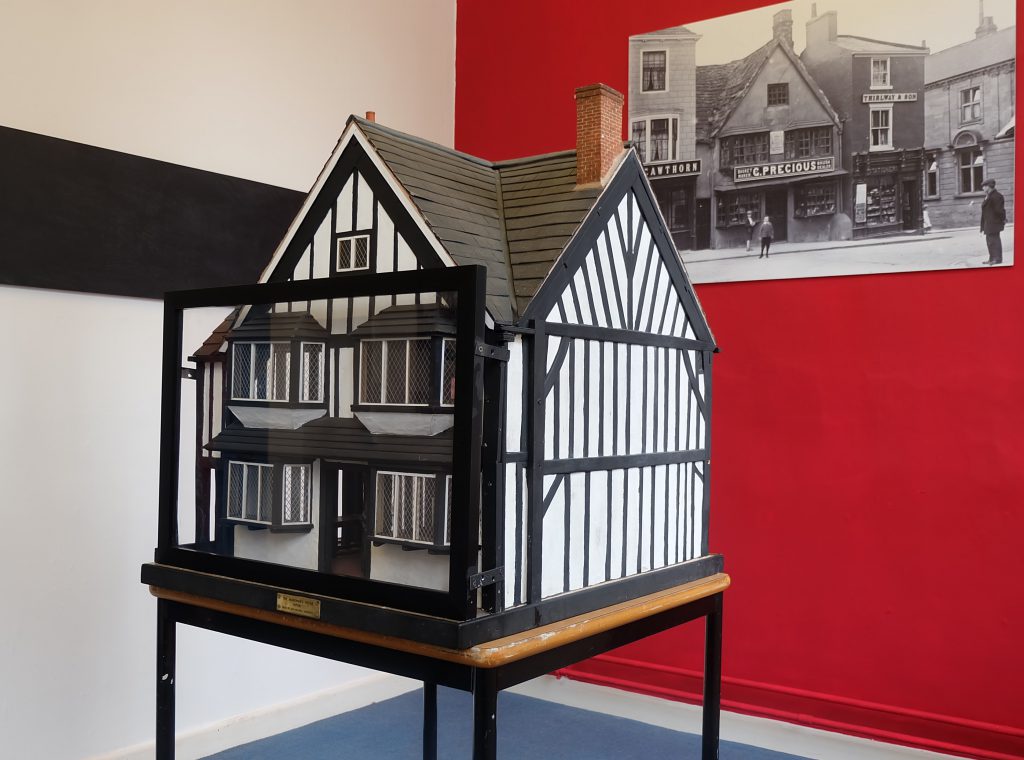Our first Object of the Month, for August 2018, is a model of the Wakeman’s House, one of the most recognisable buildings in Ripon. The model was made by Jack Halliwell of Harrogate, who donated it to Ripon Museum Trust’s collections in July 2018.
The model was made with the exact proportions and architectural features of the original building, even down to the front door that catches on a beam when opened. Peering in through the windows, you can see miniature replicas of the furniture in the building – tiny benches, tables and even a dog!
The Wakeman’s House
The Wakeman’s House is situated in the corner of Ripon market square. It dates from the late medieval period, probably the 1500s or 1600s. The building is timber-framed and was originally plastered, with a stone slate roof.
The building has long been associated with Hugh Ripley, the last Wakeman and first Mayor of Ripon, though there is no evidence that he actually lived there.
As Wakeman of Ripon, Hugh Ripley was responsible for ‘setting the watch’ each evening. Setting the watch is a tradition that dates back to the year 886. In that year, Ripon was first granted a Royal Charter by King Alfred the Great, which was symbolised by the giving of a horn. To protect their settlement, the King advised the people of Ripon to be more vigilant about the dangers of the Vikings, who were raiding up and down the east coast of the country. He suggested they appoint a Wakeman, who would stay awake and patrol the settlement and surrounding areas from dusk until dawn, watching out for any approaching enemies. He would sound the horn that was given by King Alfred at the four corners of the market square at nine o-clock each night to let people know that the watch was set and that he was on patrol.
To pay the Wakeman for his duties, a tax was imposed on the citizens of Ripon. The amount levied would be based on the position of the house door – the tax was higher if the door faced onto the market square and lower if the door was to the side or the back of the house. After this tax was introduced, many houses were designed with the door at the side of the building to avoid the higher tax.
This system was in place until 1604, when a second charter was granted to Ripon by King James I. It was decided at this time that Ripon should become more democratic, as the Wakeman had become too powerful. The office of Wakeman was discontinued and a Mayor was elected for the first time, by a vote of all the people. The first Mayor was Hugh Ripley, who was also the last Wakeman. He wanted to keep the tradition of setting the watch going so he appointed a hornblower to carry out the duty of sounding the horn. This tradition continues today, at nine o’clock every night in the market square.
At the start of the 20th century, the Wakeman’s House was the premises of George Precious, basket maker. By the 1920s, with the house looking increasingly dilapidated, the Ripon Corporation bought it for £1250 and Alderman George Hemsworth did a lot of renovation work. Since then, the building has been used as a warehouse and shop, an antique dealers, a museum and now a café.
